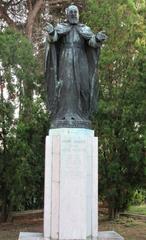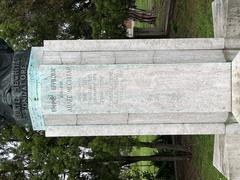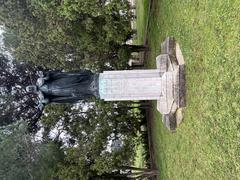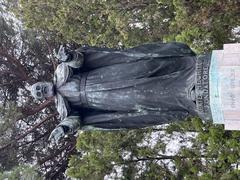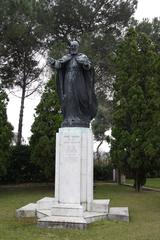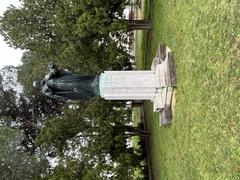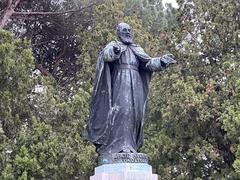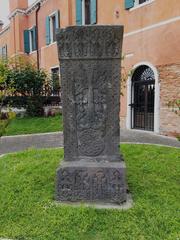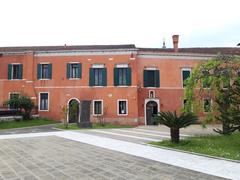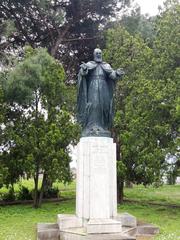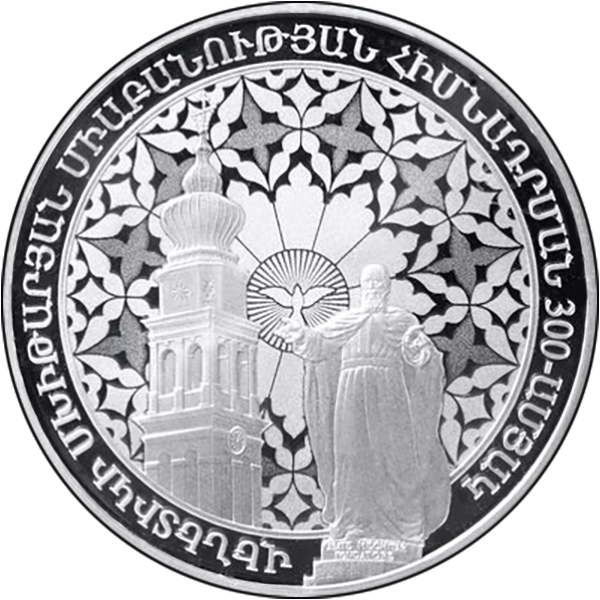
Mekhitarist Monastery of Mkhitar Sebastatsi: Visiting Hours, Tickets, and History in Venice
Date: 14/06/2025
Introduction
San Lazzaro degli Armeni, located on a serene island in the Venetian Lagoon, stands as one of the world’s most significant Armenian cultural and religious centers. Founded in 1717 by the visionary monk Mkhitar Sebastatsi, this monastery has evolved into a beacon of Armenian scholarship, preserving a wealth of manuscripts, artifacts, and traditions. Today, the island welcomes visitors who are eager to discover its unique history, admire its architecture, explore its collections, and experience the tranquil beauty of its gardens.
This comprehensive guide provides all the essential information for planning your visit to San Lazzaro degli Armeni, including historical background, insights into its collections, practical visiting hours, ticketing procedures, accessibility, and travel tips. Whether you are a history enthusiast, a researcher, or a curious traveler, San Lazzaro offers an unforgettable encounter with centuries of Armenian and Venetian heritage. (Venice Travel Guide, Armenian History, Wikipedia)
Table of Contents
- Introduction
- Historical Background: Mkhitar Sebastatsi and the Mekhitarist Congregation
- Cultural and Scholarly Legacy
- Architecture and Notable Collections
- Visiting San Lazzaro degli Armeni: Hours, Tickets, and Accessibility
- How to Get There and Nearby Attractions
- FAQs
- Conclusion
- References
Historical Background: Mkhitar Sebastatsi and the Mekhitarist Congregation
The Founder’s Vision
Mkhitar Sebastatsi (1676–1749) was born in Sebaste (now Sivas, Turkey) and was educated in Armenian theology and philosophy. Recognizing the decline of Armenian cultural and religious life under Ottoman rule, he envisioned a renewal that blended the traditions of the Armenian Church with Western monastic educational models. In 1701, he founded a monastic order in Constantinople, but religious and political pressures forced him and his followers into exile. (Armenian History)
Their journey led them first to Methoni (Greece) and ultimately, in 1717, to the island of San Lazzaro, granted by the Venetian Republic. The monks restored and expanded the existing buildings, transforming the island from a former leper colony to a flourishing center of Armenian learning and culture. By 1740, the monastery’s main structures were completed, and the Mekhitarist Congregation was recognized for its intellectual and spiritual contributions.
Growth and Influence
The Mekhitarists established a renowned library and a pioneering printing press, producing Armenian books, treatises, and translations of European literature. The library grew to house over 150,000 volumes and 4,000 manuscripts, making San Lazzaro one of the world’s foremost repositories of Armenian heritage. The congregation’s efforts were crucial in preserving Armenian culture, especially during periods of adversity.
A significant moment in the monastery’s history came in 1810, when Napoleon’s decree recognized San Lazzaro as a scientific academy, safeguarding it during a time when many other religious institutions were suppressed. The Mekhitarists’ focus on education, language, and cultural preservation played a pivotal role in the broader Armenian Renaissance and the rise of Armenian national identity in the 19th century. (Wikipedia)
Schism and Reunification
In 1773, internal disagreements led to the founding of a second Mekhitarist branch in Vienna. Both the Venice and Vienna monasteries operated independently, each contributing significantly to Armenian scholarship. The two were reunited in 2000, with Vienna serving as the principal abbey. (Wikipedia)
Cultural and Scholarly Legacy
Library and Manuscript Collection
San Lazzaro’s library is among the most important in the Mediterranean, containing approximately 170,000 volumes and more than 4,500 Armenian manuscripts, some dating back to the medieval era. Highlights include the first Armenian book printed in Venice in 1512, rare early editions, and manuscripts in multiple languages. The climate-controlled archives preserve invaluable documents central to Armenian, Byzantine, and Middle Eastern studies. (Visit Lido, Educated Traveller)
Printing Press
The island’s 18th-century printing press revolutionized Armenian scholarship, standardizing the language and producing dictionaries, grammars, religious texts, and scientific works. The press enabled the dissemination of Armenian literature throughout the diaspora and remains a symbol of the monastery’s intellectual mission. (Armenian History)
Museum and Art Collections
The museum displays a remarkable array of artifacts, including:
- Archaeological finds from Armenia and the Near East.
- Ancient manuscripts and religious relics.
- Artworks by Venetian and Armenian masters.
- The sword of Leo V, last King of Cilician Armenia.
- A 15th-century BCE Egyptian mummy, gifted to the monastery in 1825.
Exhibits also feature Etruscan vases, Chinese porcelain, and an Indian throne, reflecting the monastery’s global connections. (Spotting History, Visit Lido)
The Lord Byron Connection
The English poet Lord Byron famously studied Armenian with the monks during his stay in Venice in 1816, producing translations and contributing to the monastery’s international reputation. The so-called “Lord Byron Room” features memorabilia from his time on the island.
Architecture and Notable Collections
San Lazzaro degli Armeni’s monastic complex encompasses:
- The Church: Featuring Gothic and Baroque elements, three naves, and stained glass windows depicting Armenian saints.
- Cloister and Gardens: Beautifully landscaped spaces for contemplation, with Mediterranean and Armenian flora.
- Library and Archives: Housing precious manuscripts and rare books.
- Museum and Art Gallery: Exhibiting religious art, ancient artifacts, and ethnographic items.
- Print House: The historic printing press, still on display. (Meeting Venice, Europe for Visitors)
The island’s peaceful gardens and striking architecture provide a tranquil retreat from the bustle of Venice.
Visiting San Lazzaro degli Armeni: Hours, Tickets, and Accessibility
Visiting Hours
- Guided Tours: Required for entry; typically offered Tuesday to Sunday, 3:00 PM–6:00 PM (last admission at 5:00 PM).
- Closed: Mondays and major holidays.
- Tour Duration: 60–90 minutes.
- Languages: Italian and English, with other languages on request. (San Lazzaro Official Site)
Tickets and Booking
- Admission: Minimum €8 donation, paid at the start of the tour (cash preferred).
- Booking: Advance reservation is required. Book via official website, email ([email protected]), or phone (+39 041 526 0104).
- Group Size: Tours typically limited to about 18 visitors.
Accessibility
- Mobility: The island has some uneven paths and steps; partial accessibility for visitors with disabilities. Contact the monastery in advance for specific accommodations.
- Restrooms: Available during the tour.
Visitor Guidelines
- Dress Code: Modest attire (shoulders/knees covered) is required.
- Photography: Permitted outdoors; restricted inside some exhibition areas.
- Children: Welcome, but must be supervised and respectful.
How to Get There and Nearby Attractions
Getting to San Lazzaro degli Armeni
- Vaporetto: Take ACTV Line 20 from San Zaccaria pier (near Piazza San Marco) at 3:10 PM. Journey is approx. 20 minutes; inform crew of your stop as it is a request stop.
- Private Water Taxi: Available for flexible schedules.
- Return: Book your return transfer as needed; the vaporetto schedule may be limited.
(Europe for Visitors, Meeting Venice)
Nearby Attractions
- San Servolo Island: Art and history museum.
- Lido di Venezia: Beaches and film festival.
- Venice Historic Center: Piazza San Marco, Doge’s Palace, Murano and Burano islands.
Combine your visit with a lagoon tour or explore other iconic Venetian sites for a full cultural experience.
Frequently Asked Questions (FAQ)
Q: What are the visiting hours for San Lazzaro degli Armeni?
A: Guided tours are available Tuesday to Sunday, 3:00 PM–6:00 PM; closed Mondays.
Q: How do I book tickets?
A: Advance reservations are required via the official website, email ([email protected]), or phone (+39 041 526 0104).
Q: How much does it cost to visit?
A: There is a suggested minimum donation of €8 per person.
Q: Is the monastery accessible for people with disabilities?
A: Some areas are accessible; contact the monastery in advance to discuss specific needs.
Q: Are guided tours mandatory?
A: Yes, entry is only possible via guided tours.
Q: Can I take photographs?
A: Yes, in outdoor areas; interior photography is restricted to protect artifacts.
Q: How do I get there from Venice?
A: Take vaporetto Line 20 from San Zaccaria to San Lazzaro degli Armeni; check schedules in advance.
Conclusion
San Lazzaro degli Armeni stands as a living monument to the resilience and creativity of the Armenian people. Its exceptional library, art, and architecture, combined with a welcoming monastic community, make it one of Venice’s most rewarding destinations for cultural travelers and scholars alike. Plan ahead by checking current visiting hours and booking your tour to ensure a smooth and enriching visit to this unique island retreat.
For more information and updates, consult the official website, and consider downloading the Audiala app for audio guides and travel tips.

